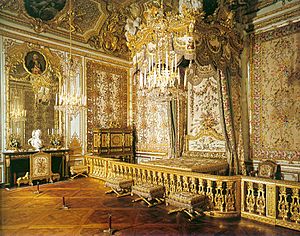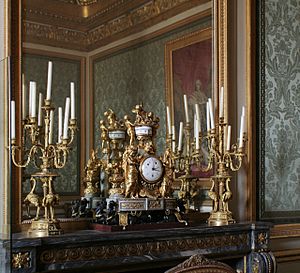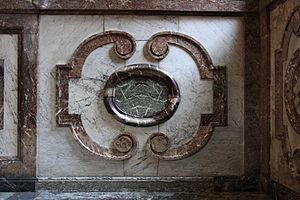Queen's apartment at Versailles facts for kids
The Queen's apartment at Versailles (in French, Grand appartement de la reine) is a special set of rooms in the famous Palace of Versailles. These rooms include the Queen's Bedchamber, her private offices, and rooms for her guards and gentlemen.
The apartment looks out over the beautiful Parterre du Midi gardens. It is also right next to the King's Apartment. Even after King Louis XIV stopped using his apartment, the Queens continued to live in the Queen's Apartment.
Contents
The Queen's Bedchamber
The most important room in the Queen's Apartment is The Queen's Bedchamber. It was first designed for King Louis XIV's wife, Marie Thérèse of Austria. Three queens lived in this room: Marie Thérèse, Marie Leszczyńska, and Marie Antoinette. After Marie Thérèse passed away in 1683, two future queens, Marie-Christine of Bavaria and Marie-Adélaïde of Savoy, also used it.
The ceiling of the room is from Marie Thérèse's time. The beautiful paintings by François Boucher and the wooden panels were made for Marie Leszczyńska. This decoration stayed the same for Marie Antoinette. Only the furniture and fireplace were updated for her.
The Queens spent most of their time in this room. The Queen slept here, and sometimes the King joined her. An amazing nineteen royal children were born in this very bedchamber! In the mornings, the Queen would receive visitors. She would also get ready (her toilette) in this room. This was a public event, meaning many people watched her.
In October 1789, during the French Revolution, rioters stormed the palace. Marie Antoinette quickly escaped through a small door next to her bed. This secret passage led to her private rooms and the King's Apartment.
The palace was not looted during the Revolution. Instead, many items were sold at a large auction that lasted a year. Some original pieces, like the Schwerdfeger jewel case and the firescreen, were later returned. Other items have been replaced with similar ones from that time. The fabric on the walls and bed was rewoven to match the original designs. The bed and the railing around it were rebuilt using old documents.
Restoring the Queen's Bedchamber took 30 years of hard work. It involved a lot of research and careful rebuilding. Even the 1745 Baillou and Crescent clock, which Marie Antoinette had in her room, has been put back. Other items returned include the chimney piece by Sené and the bedspread by Desfarges. Some original furniture, like the andirons by Boizot and Thomire, have been found and returned. Other pieces, like armchairs and folding stools, are copies of the originals. The Savonnerie carpet was rewoven from old records.
Gallery: The Queen's Bedchamber
The Queen's Private Cabinets
The Queen's Private Cabinets were small, private rooms. The Queen could reach them through a hidden door in her bedchamber. These rooms are on a higher level, looking out over the inner courtyards. They don't get much sunlight.
The Meridian Cabinet was once a prayer room for the Duchesse de Bourgogne. It was redecorated for the birth of the Dauphin (the King's son) in 1781. A table made of petrified wood in this room once belonged to Charles I of England. Marie Antoinette received it as a gift from her mother.
The blue Grenadière Cabinet is a copy of the original. The Gold Cabinet has decorations inspired by ancient designs. These include tripods, sphinxes, and figures called caryatids near the fireplace. This room used to be the bedchamber of the Duc de Bourgogne. Marie Antoinette placed a pineapple sculpture by Oudry above the door. This was to honor the plant research done at the Trianon under King Louis XV. Furniture in these rooms includes a chest of drawers by Riesener (1779) and a harp by Naderman.
Gallery: The Meridian Cabinet
The Room of the Queen's Gentlemen
The Room of the Queen's Gentlemen (also called The Room of the Nobles) was where the Queen officially met important visitors like ambassadors. Marie Leszczyńska would sit under a special canopy here. She held formal meetings and social gatherings for the ladies of the court. This room was once known as the Queen's Drawing Room.
In 1785, the room was redecorated. Marie Antoinette kept only the ceiling paintings. She had the walls covered with apple-green damask fabric with a wide gold stripe. New, very modern furniture was brought in. Riesener, the Queen’s favorite furniture maker, created chests and cabinets in the latest English style.
The ceiling paintings by Michel Corneille show Mercury, the Roman god, spreading his influence over the arts. A tapestry portrait of King Louis XV by Cozette hangs on the wall. There are also mythological paintings by François Boucher. The decorations on the fireplace show a Turkish influence. The chests of drawers and corner cupboards by Riesener and Gouthière are from 1786. Above the doors are paintings by Regnault showing stories of Pygmalion and Dibutade.
The Queen's Antechamber
The King and Queen ate their meals in The Queen's Antechamber. This was a public event, meaning many people watched them eat. King Louis XVI and Marie Antoinette sat with their backs to the fireplace. Only the royal family could sit at the table. Important people like duchesses and princesses were allowed to sit on stools facing the royals. Other high-ranking guests had to stand.
King Louis XIV enjoyed this public dinner ritual. King Louis XV preferred more private suppers. King Louis XVI ate well. However, Marie Antoinette often found these public dinners boring. One person who watched reported: "The Queen sat on the King’s left. They had their backs turned to the fireplace [...] The King ate with a good appetite, but the Queen did not remove her gloves and did not use her serviette (napkin), which was very wrong of her." To make it less boring, the Queen asked for music at every meal. A special platform was set up for musicians.
This room was once The Room of the Queen's Guard. In the 1680s, it was sometimes used as a theatre. The ceiling paintings by Vignon and Paillet show royal virtues through ancient heroines. Portraits of King Louis XVI's aunts by Madame Labille-Guiard are also part of the decor. Above the doors are works by Madeline de Boulogne from 1675.
The Room of the Queen's Guard
The marble panels in The Room of the Queen's Guard were made even more beautiful with gilded bronze. These designs were by Le Brun and created by Le Gros and Massou. The room was used as a Chapel in 1672. It received its final decorations between 1676 and 1681. The paintings in this room are by Noël Coypel and were moved from another room called the Jupiter Drawing Room.
At the bottom of the Queen’s staircase, also known as the "marble staircase," you entered the Queen’s Grand Apartment through this Guard room. Here, day and night, twelve bodyguards served their Queen. At Versailles, only the King, the Queen, and the Dauphin (the King's eldest son) had their own personal guards. These guards were elite soldiers from the King’s bodyguard companies. The next large room, now called the Salle du Sacre (Coronation Room), was also used by them as a guard room.
The Queen’s Guard Room is the only room where the 17th-century decoration has been kept. Since the Queen didn't use this room much, it wasn't updated. This is why you can still see the marble panels, which were typical of the first Grand Apartments. The paintings placed here in 1680, which came from the former Jupiter room, are also still here.
The bodyguards' job at the palace included guarding the apartment doors. They would stand ready with their weapons when royal family members passed by. They also guarded the chapel during mass and escorted the royal family during their dinners. They had to know all the dukes and peers. When these important people passed, the guard had to stand at attention and stamp his right heel twice. The guard also had to open the door himself and not let anyone else do it.
It was in this room in 1789, early in the morning, that rioters demanding bread tried to reach the Queen's apartments. A chambermaid, warned by a bodyguard, quickly locked the door to the Room of the Queen's Gentlemen. She told the Queen to run away. The rioters then turned back and tried to get in through the King's Guard Room instead.
Images for kids
Queens and Dauphines
-
Marie Thérèse of Austria, Queen of France (married Louis XIV)
-
Marie Leszczyńska, Queen of France (married Louis XV)
-
Marie Adélaïde of Savoy, Dauphine























